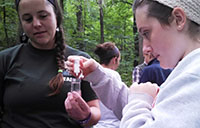

Find Out if Your Streams Are Healthy
The Hoosier Riverwatch program offers hands-on opportunities for you, your school, or your organization to get involved in monitoring the health of your local streams and maybe even assist with improving water quality problems that exist. An active community can and does make a big difference! Hoosier Riverwatch will help you to:
- Understand sources of water pollution.
- Understand what is happening in your watershed.
- Set up a program for monitoring local water quality.
Take these steps and get started today!
Inform Yourself
Follow Hoosier Riverwatch activities by reading the quarterly Riffles & Pools newsletter.
Educate Yourself
Sign up for -- and even help organize and host -- a Hoosier Riverwatch workshop in your area.
Equip Yourself
Borrow stream monitoring equipment once you are trained, and maybe even submit the Hoosier Riverwatch Water Monitoring Equipment Application (State Form 55220, available on the IDEM Agency Forms page) for monitoring equipment if you meet eligibility criteria.
Involve Yourself
Enter, map, and view data, and graph your own and others’ data on the Hoosier Riverwatch online database.
Attend an advanced training workshop—which covers topics such as monitoring E. coli bacteria, identifying aquatic organisms accurately, collecting better quality data, and more—when one is offered.
Pass It On
Encourage others (your children and neighbors, perhaps?) to get informed and to follow in the footsteps of other resource stewards around them so that they, in turn, can pass it down to the next generation.
Incorporate Hoosier Riverwatch Into School Curriculums
Educators can use Hoosier Riverwatch to involve students in local environmental projects while meeting many and varied curriculum outcomes. Hoosier Riverwatch:
- Promotes student-led actions and taking responsibility for the environment.
- Increases students’ knowledge and understanding of their local environment (i.e., water, soils, vegetation, and land) and sustainable use of natural resources.
- Builds skills in scientific methodology, data collection, teamwork, communication, problem solving, and logical thinking.
- Trains students in methods of water quality data collection and habitat assessment.
- Allows students to collect data that contributes to the statewide data pool of information about water resources.
